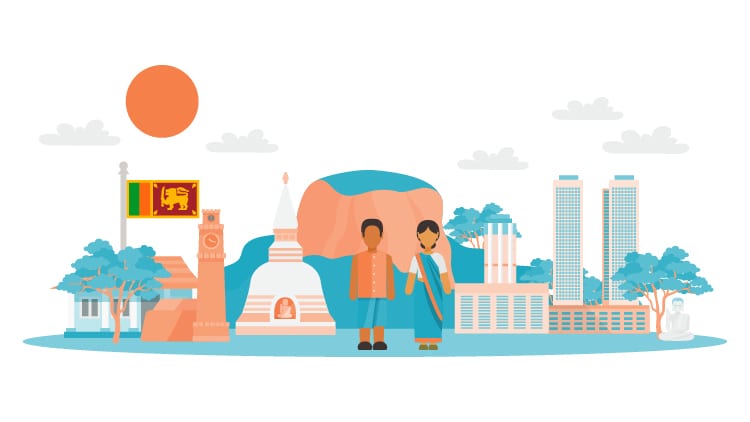Facts About Sri Lanka Language

Sri Lanka:
Located in the Indian Ocean, Sri Lanka is an island country in South Asia. Although the documented history of the country is only 3000 years old, there is evidence of prehistoric human settlements on the island dating back to 125,000 years. The country is known for its rich cultural heritage. Sri Lanka has been a trader of luxury goods and spices for centuries. This attracted the attention of various nations. This is why the country has such a diverse population today. Both Portuguese and Dutch settlers tried to gain control over the island. Ultimately, it was the British people who ended up establishing their colonial rule over Sri Lanka. The people of Ceylon (the previous name of this island) won their independence from the British colonizers in 1948. The country has to go through a civil war that lasted for 26 years. The civil war ended in 2009 when the Armed Forces defeated the Liberation Tigers of Tamil Eelam.
Ethnic Groups and Languages:
Sri Lanka is home to various ethnic groups, cultures, and languages. The Sinhalese make up 75% of the population. Sri Lankan Tamils are the largest minority group in the country. Other popular ethnic groups are Moors, Malays, Chinese, Burghers, and the indigenous Vedda.
Sinhala is the most popular language in Sri Lanka, but various other tongues are spoken by the Sri Lankans. The Muslims of the island use Arabic for religious purposes. A small community of Portuguese descendants speak Sri Lankan Portuguese Creole. English is also spoken as a native language by the people of urban areas. Some 40,000 people speak Sri Lankan Malay. Tamil is the second most popular language in the country. It is spoken by both Sri Lankan Tamils and the Tamil immigrants from the Indian state of Tamil Nadu.

Facts About Sri Lanka Language:
There are two official languages in Sri Lanka: Sinhala and Tamil. English is also recognized in the constitution as the link language. The English language is spoken by more than 20% of the population. It is also used for official purposes all over the country. But it is the Sinhala language which is spoken by the majority, 75% of the population. It is the Sri Lankan language that foreigners need to learn if they want to settle down in this island country.
Here are a few facts about the Sinhala language:
1. It is an Indo-Aryan language natively spoken by the Sinhalese people. The influence of Dravidian languages, mostly Tamil, has made Sinhala different from other Indo-Aryan languages.
2. It has 17 million native speakers. Along with the Sinhalese people, other groups of the island also speak it as their first language.
3. It has adopted various words from the Tamil language.
4. It is written in the Sinhala script, which was derived from the ancient Brahmi script. The alphabet has 58 letters, out of which 38 are used commonly.
5. Many European languages have also influenced Sinhala. The reason behind that is not just colonialism but also assimilation, interaction, and intermarriage. Out of all the European languages, Portuguese, Dutch, and English have influenced the Sri Lankan national language the most.
6. Instead of dialects, the different varieties of this language are known as variations. The Uva variation and the southern variation are the most popular regional variations.
7. Literary Sinhala is different from the spoken language. The written form is more formal, whereas the spoken variety has slang words and is used for everyday conversations. This characteristic is known as diglossia.

The Language Divide in Sri Lanka:
Although the country is multilingual, Sri Lankan English and Sinhala are the ones that get preferential treatment from the state. Minority languages often get ignored. Although Tamil was declared an official language to satisfy its speakers, it still does not get the same treatment as the other two state languages. As a result, the Tamil-speaking people feel disconnected from the rest of the country. A new language policy has been made by the government to ensure trilingual fluency in future generations. The education system needs to be changed to implement the language policy in a better way.
By ensuring trilingual fluency, human rights can be protected on the island in a much better way. It is the only all the people of Sri Lanka can get the help they need from government officials, whenever they need it. The people of the island managed to keep their languages intact during colonial times. It is up to them now to reduce the language divide and give equal importance to both the official languages of the country.
The language policy can be really helpful for the future of Sri Lanka. It can bring the people of the country together. It will not reduce the importance of Sinhala but give Tamil the attention that it deserves. In all Asian countries, the mother tongue of a person is an important part of their identity. But if Sri Lankan and Indian Tamils cannot get support from the state for their vernacular, they will feel isolated.
Translations of Sinhala:
A foreign company that wants to connect with the people of Sri Lanka should get translations in the official languages of the country. If they only want to get translations in one tongue, then they should go with the national language. It will help them connect with the majority of the population. For language solutions, no one should turn to Google Translate. If you want your business to succeed, then you should not seek help from Google. You will need a native translator, instead of Google, to get high-quality translations.
When you show your audience ads in their spoken language, they will be impressed instantly. They will also feel connected to you if you release advertisements in the spoken language of your target audience. So, get in touch with qualified professionals and ask for translations in the national language of Sri Lanka, and you will be able to get accurate linguistic solutions. Once you get the translations, you will be able to advertise your brand in all the Sinhala-speaking areas.
Linguistic Heritage of Dravidian Influences in Southeast Asia
The Dravidian language family, encompassing languages like Tamil and Telugu, has played a significant role in shaping the linguistic landscape of Southeast Asia. In the 19th century, Sinhalese, belonging to the Dravidian family, emerged as a primary language in Sri Lanka. Sinhalese not only served as a literary language but also contributed to the development of classical languages in the region.
One distinctive feature of Dravidian languages, including Sinhalese, is the presence of inherent vowels, which add richness to their phonetic structure. The historical interplay of these languages has left an indelible mark on the cultural tapestry of Southeast Asia, influencing both spoken communication and written expressions.
The Austronesian language landscape witnessed a profound transformation during the course of history, particularly under the influence of colonial powers. In the 3rd century, the Austronesian-speaking regions saw the emergence of Creole languages as a result of cultural exchanges during early trade and interactions. However, the impact of British rule in the 19th and 20th centuries also played a pivotal role in shaping linguistic dynamics.
The use of Austronesian languages as liturgical languages persisted, reflecting their historical importance and cultural significance. These languages, with roots tracing back to ancient times, evolved alongside the sociopolitical changes brought about by colonial powers. This linguistic evolution represents a complex interplay of cultural, historical, and linguistic factors that have left a lasting imprint on the Austronesian linguistic heritage from the 5th century to the present day.
Academic Influence of Language Studies and Scholarly Endeavors
The University of London holds a unique position in the academic landscape, and its influence extends far beyond its geographical location. The Sinhala people, with their rich cultural heritage dating back to ancient times, have contributed significantly to the linguistic diversity of the region. Sinhala, with its substrate influence from the Middle Indo-Aryan, has distinct features, including independent letters, that reflect its evolution over the centuries. As a part of the Northern Indo-Aryan language group, Sinhala serves as a linguistic link to its parent stock, preserving elements of historical continuity.
This linguistic tapestry is woven into various aspects of Sinhala culture, from public speeches to modern communication channels like blog posts, showcasing the dynamic interaction between tradition and contemporary expression in the linguistic legacy of the Sinhala people.
Language classes and exchange programs play pivotal roles in fostering linguistic diversity and understanding. In the realm of language studies, the concept of pro-drop languages, where subjects are often omitted from sentences, adds a layer of complexity and cultural nuance. Institutions such as Johns Hopkins University Press and Oxford University Press contribute significantly to linguistic scholarship, producing comprehensive resources and publications. The University of Madras Tamil Lexicon, a noteworthy endeavor, delves into the rich linguistic heritage of Tamil.
The University of Oxford, a global academic hub, is renowned for its linguistic research and language programs. Exploring the complete scripts of Indian languages, characterized by unique Indian scripts and monophthong vowels, enhances our appreciation for the intricate linguistic tapestry woven across the Indian subcontinent.
Sinhala’s Dravidian Influence in Sri Lanka
The Sinhalese language, spoken in Sri Lanka, bears the imprint of a complex linguistic history that includes the influence of Dravidian languages, particularly from South India. This linguistic interaction is evident in various aspects, such as vowel sounds and the use of so-called prenasalized consonants. The Dravidian influence, often referred to as the Influence of Dravida, has shaped the phonetic characteristics of Sinhalese.
The term “Lanka-Kuvani” signifies the unique linguistic blend in Sri Lanka, showcasing the amalgamation of indigenous elements with those from Foreign India. The Sinhalese language, with its intricate mix of native and foreign linguistic elements, stands as a testament to the rich cultural and historical connections between Sri Lanka and the broader Indian subcontinent.
Frequently Asked Questions
The primary language spoken in Sri Lanka is Sinhala.
The Dravidian influence, particularly from South India, has significantly shaped the phonetic characteristics of the Sinhalese language in Sri Lanka.
The term “Lanka-Kuvani” signifies the unique linguistic blend in Sri Lanka, highlighting the amalgamation of Indigenous elements with those from Foreign India.
Features such as vowel sounds and the use of so-called prenasalized consonants are evident in the Sinhalese language due to Dravidian influence.
The intricate mix of native and foreign linguistic elements in the Sinhalese language stands as a testament to the rich cultural and historical connections between Sri Lanka and the broader Indian subcontinent.




